
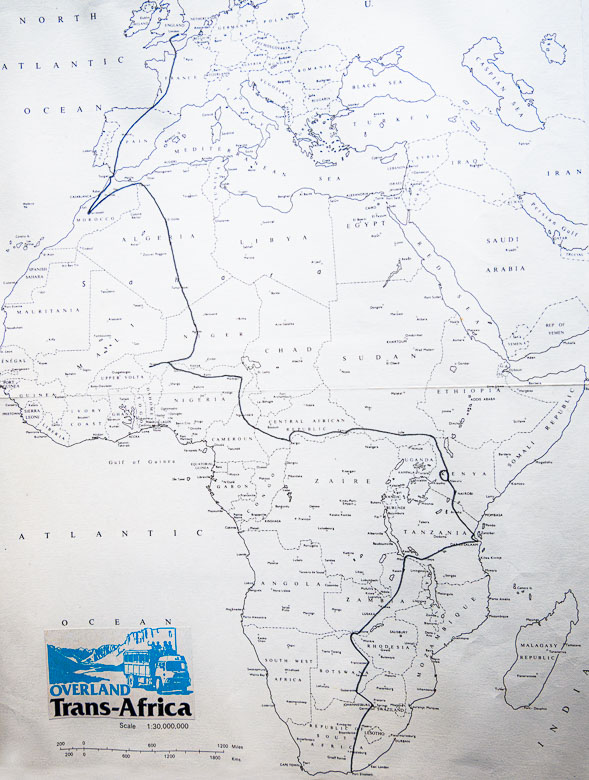
This is the seventh instalment of a four-month trans-Africa trip from Johannesburg to London that I did with Exodus Expeditions in 1980, travelling by ex-army truck and camping. We were not sightseeing, though we did see some incredible sights. Our goal was to see and experience Africa from south to north by whatever route was open. Four months. Twelve people. One truck. Fifteen countries. 18,000 kilometres. Links to the earlier posts are listed at the end of this one.
*******************************
And so it continues, the never-ending road to Bangui, the mud and the slush, the puddles, the oozing orange muck, and the relentless battle just to get through, just to make a little progress each day.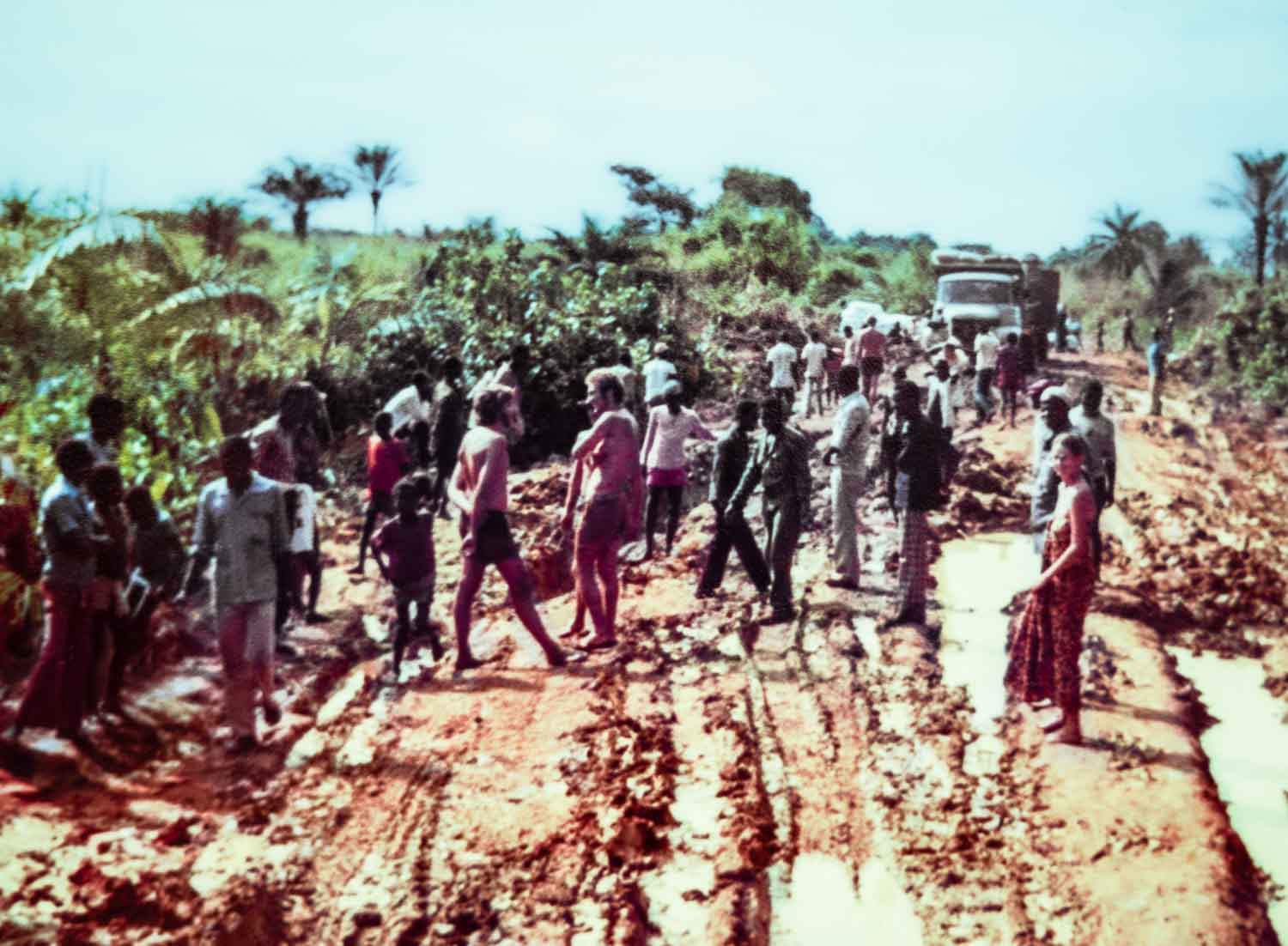
We lose track of time. It’s as if we’ve entered an alternate universe, where each day we’re presented with the same challenges over and over. There are still ferries across wide rivers to be negotiated. We wade in and drag the ramps into place, Craig or Brett drives the truck on, and locals pole us across the water, often chanting/singing as they go.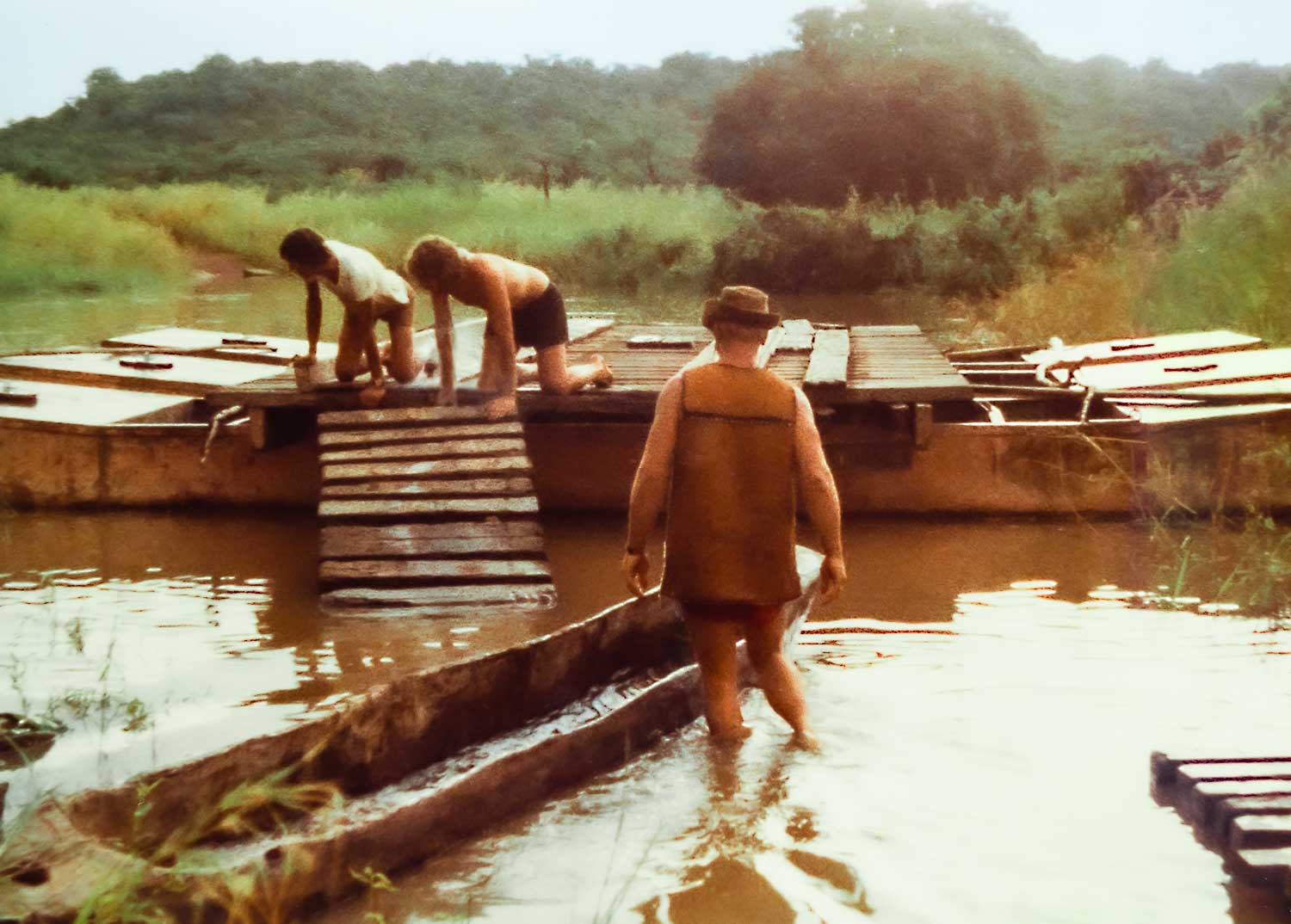
Truth be told none of us want to wade into the rivers, and there are one or two people who never do. There’s this thing called bilharzia, also known as schistosomiasis or snail fever. It’s a disease caused by parasitic worms and is the second most dangerous parasitic disease after malaria. The parasites live in some species of freshwater snails and come out of the snail into the water, and then burrow into your skin. Southern and sub-Saharan Africa are high risk areas. And yeah, we all know all about bilharzia. Once inside you those little fuckers can then lodge in just about any part of your body including the brain. Oh it’s nasty. And none of us want to get it, but it can’t be helped. We start trying to be very careful not to get into any of the rivers. After a few weeks on the road all but a couple of us realize that it’s just not possible to stay out of them; we have to take the risk because we have to keep going, we have to find a way through and getting into the rivers is part of it.
On the other side of each river there’s still the same “road”,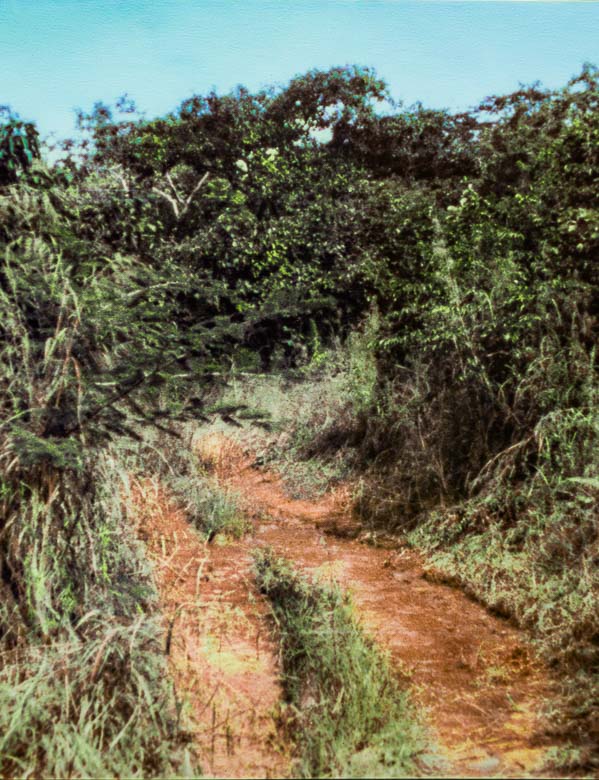
sometimes almost swallowed by the ever encroaching jungle, so that it becomes barely discernible. There are still questionable bridges to be crossed,
and the mud. Always the mud.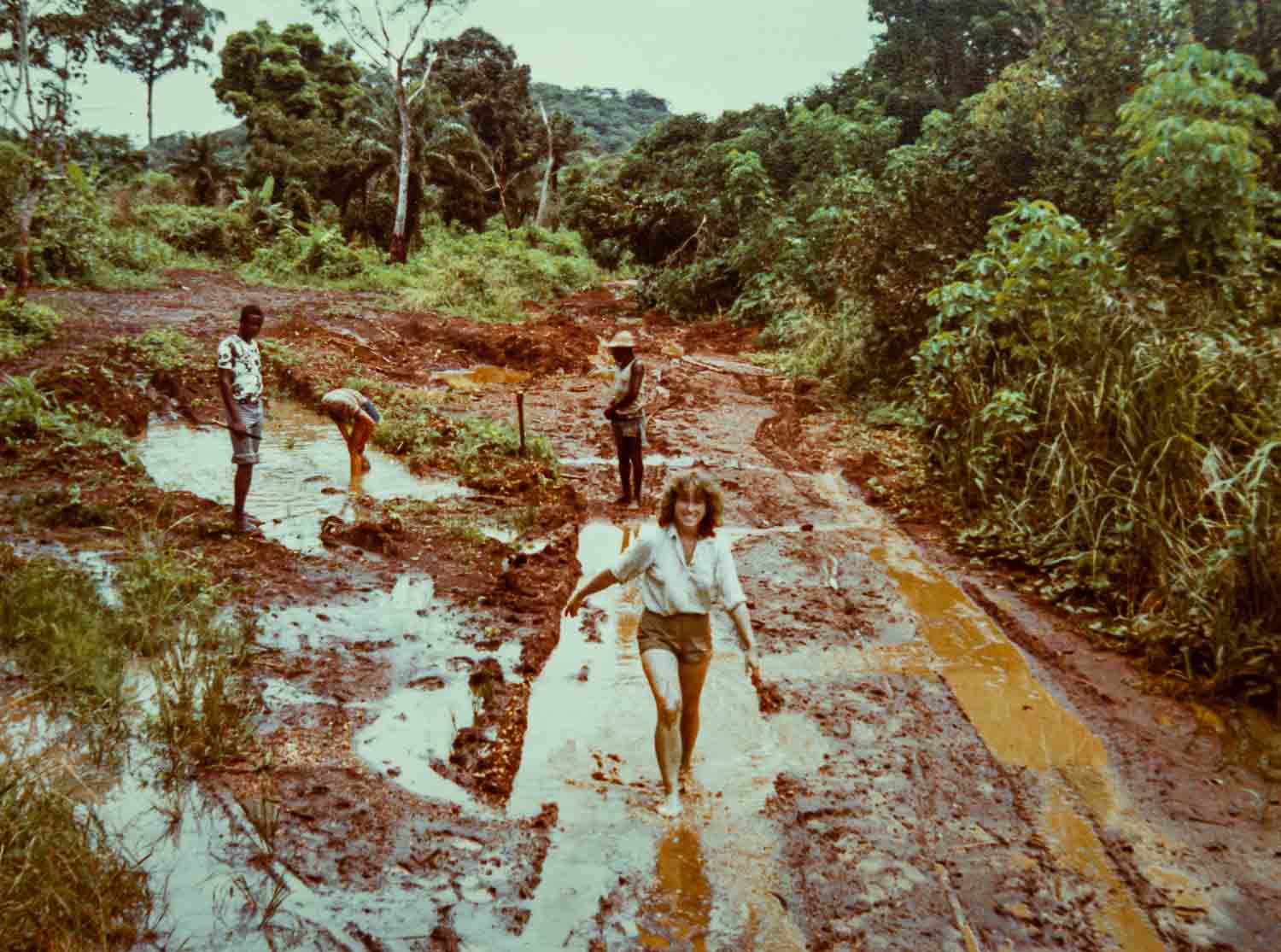
And then it happens. The truck sinks down on one side and we are bogged.
Initially it’s fine. We’ve been bogged before. The guys take turns squatting by the truck, reaching arms up to their shoulders down into the muck to stuff foliage under the wheels; anything to help get a little traction.
We take turns, on both the front wheel and the back, digging out the muck with our hands and stuffing whatever we can find under the wheels. We try winching the truck but there are not any trees strong enough to attach the winch to. So it’s back down to put more under the wheels. And every time we get more foliage under the wheels Craig starts the engine and tries to move forward as we all push. Everyone of us pushing with all our strength, over and over. Nothing. On and on it goes, without success.
We stop for lunch. Dawn’s on clean up duty and washes dishes as best she can right in the middle of the road; there’s nowhere else to go.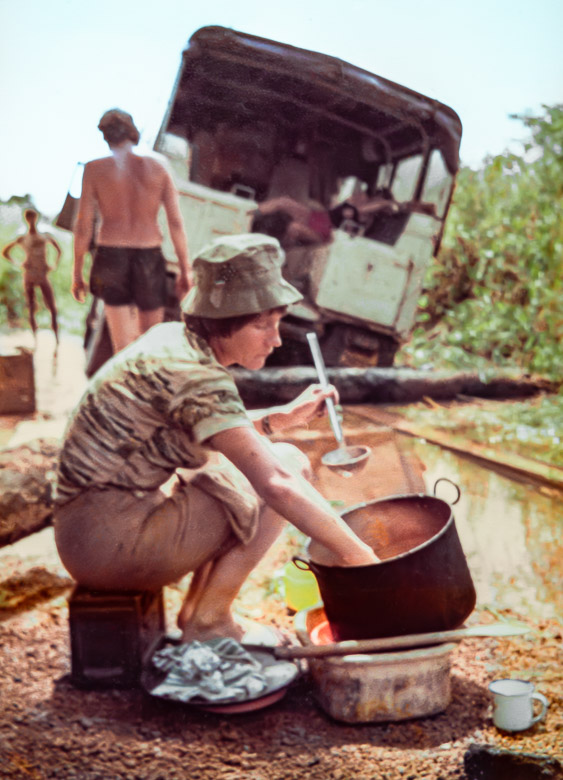
None of us are wading too far into that jungle. And when Steve emerges with the snake we give thanks that it’s already dead.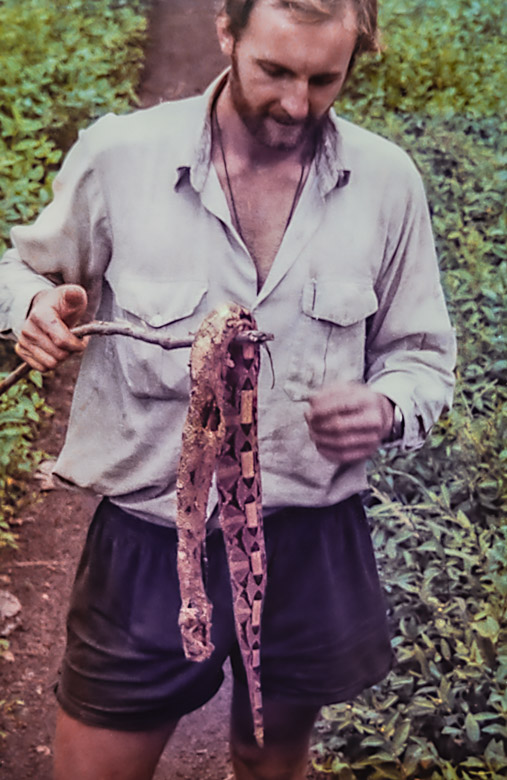
But lunch, and later a break for a cup of tea,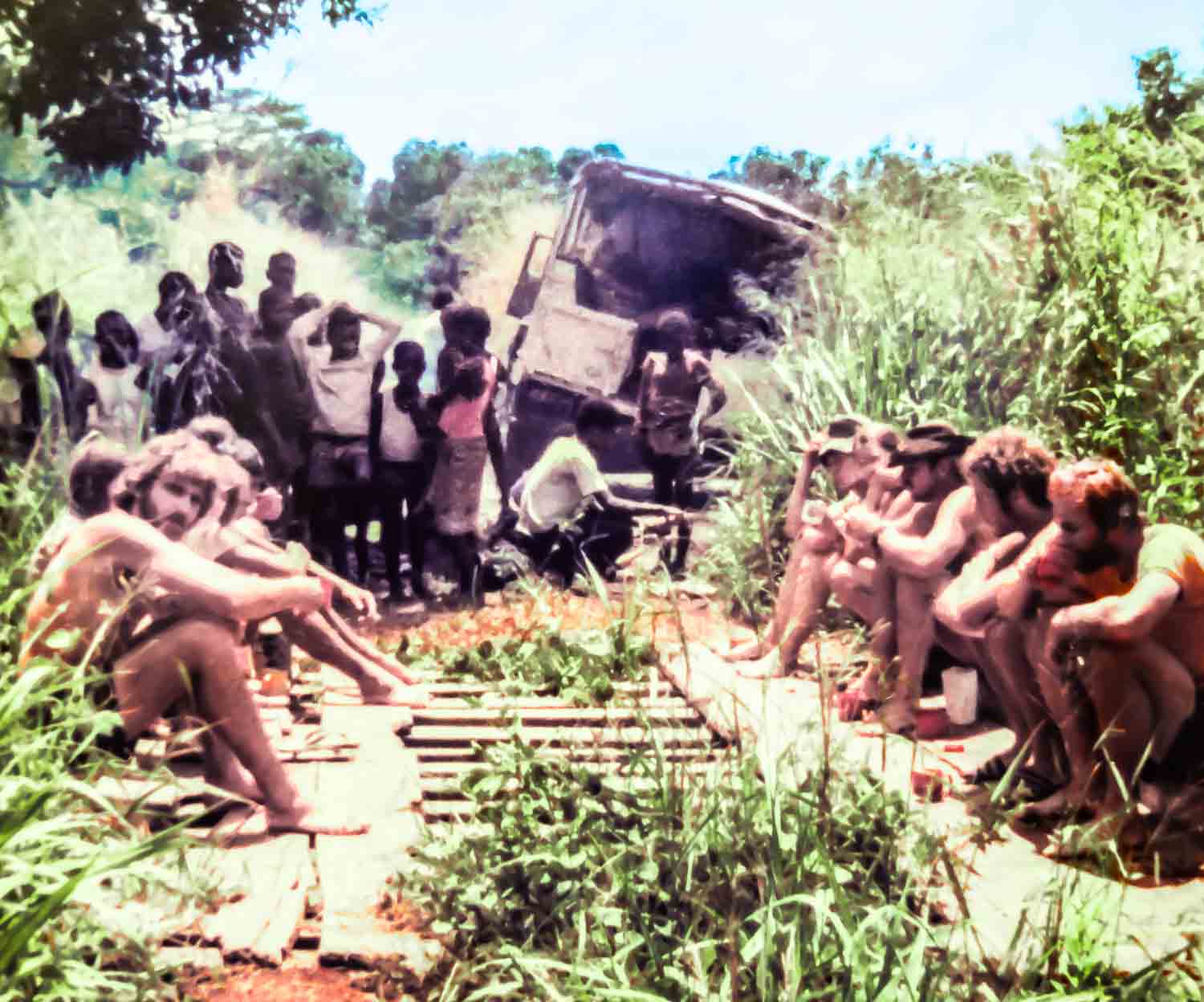
are not helping us. We are well and truly stuck.
There’s a village near by. The villagers come to watch us, staring at our predicament. For now we are the entertainment, though undoubtedly they’ve seen similar situations many times.
I don’t know why it takes Craig so long to make the decision. Perhaps he wants to try doing everything that we can possibly do to get ourselves out of there. Perhaps he’s watching the budget. Perhaps he’s not really aware of how much it will actually cost. Either way he finally caves. He walks to the village and pays the chief to help us.
Suddenly we are surrounded by every man and boy from the village, twenty or more of them. They separate into two groups, half at the front to pull and half at the back to push. They are like an army – instantly organized. And then it starts – the chanting; it’s as if it gives them strength. The entire group chants a loud strong rhythmic chant as they put all their strength into moving our truck.
In less than five minutes we are free! We’ve been bogged for ten hours, and in less than five minutes the villagers with their numbers, and their strength, and their chanting, and their unity, have us free. Hallelujah! Oh sweet relief!
But this journey is not all bad. In some ways it’s a bit of a lark, slopping around in the mud, shoes long discarded, like kids again. At the same time we know that this is no game, and that we must stay focussed and keep pushing on. And in between the hours of soul destroying slog there are moments of pure joy.
We are hailed by every village we pass through.
People shout and wave, and kids dance for us as we go by.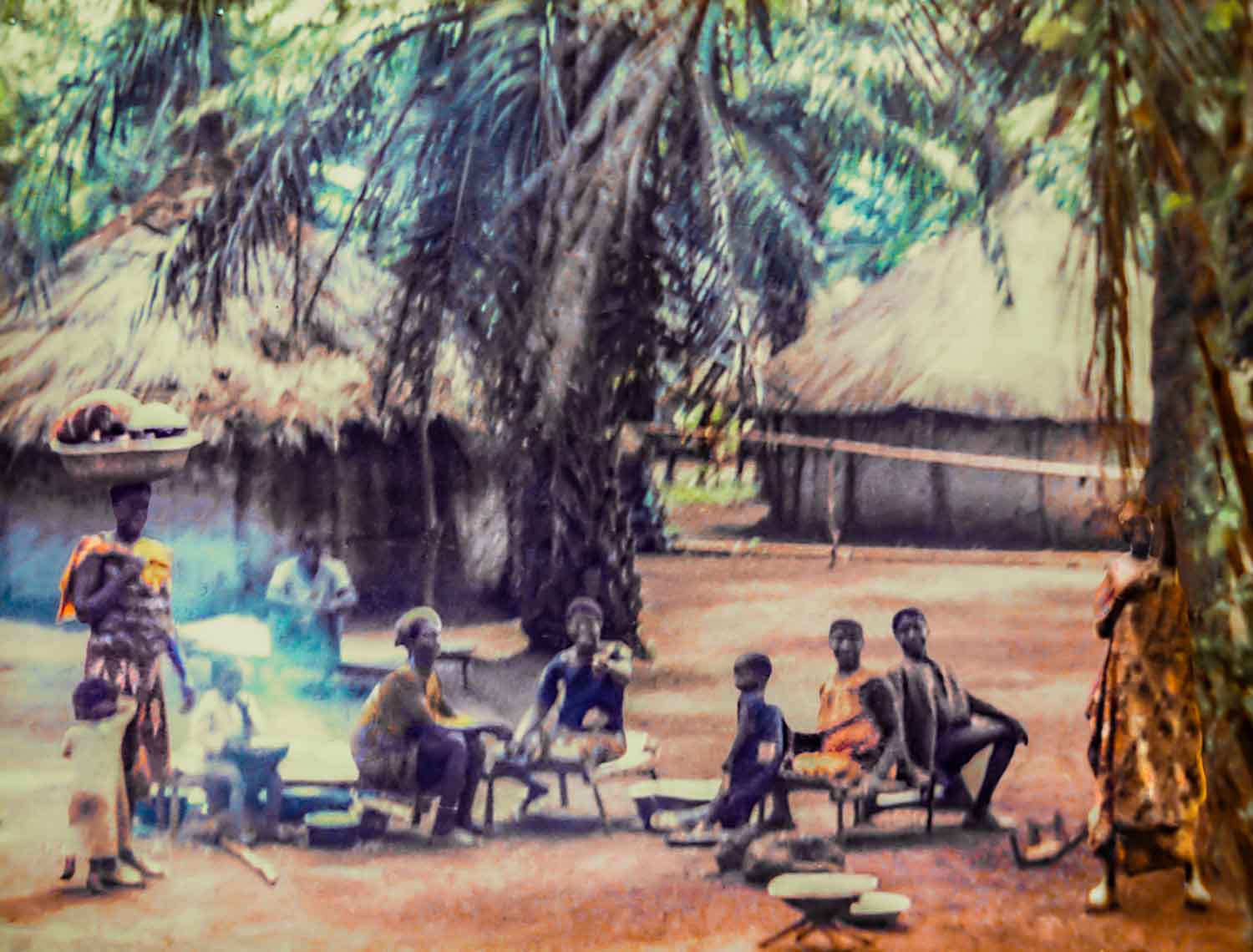
In this village, even though everyone is outdoors and there seems to be a celebration, all the kids leave it to come stare and wave at us.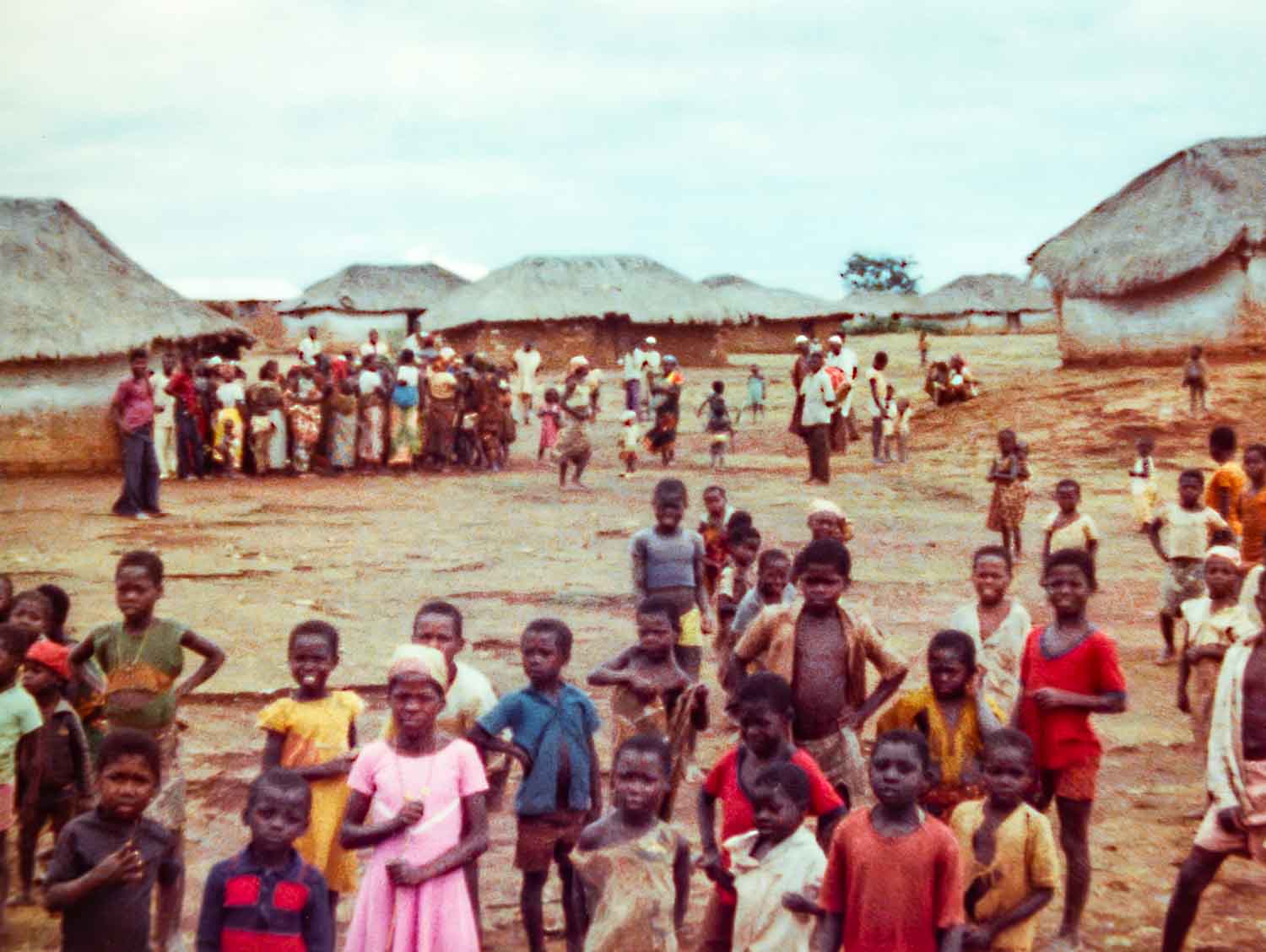
We continue shopping for fruits and vegetables at the local markets, trading our empty cans and bottles when we can. Often there is not much available but the people are unfailingly open and friendly.
We camp in a village, probably because it’s late in the day and there is nowhere else suitable. We set up the tents, get the tables down, get a fire going, make dinner. And then the drums start. Within minutes the entire village is dancing into the night and us with them.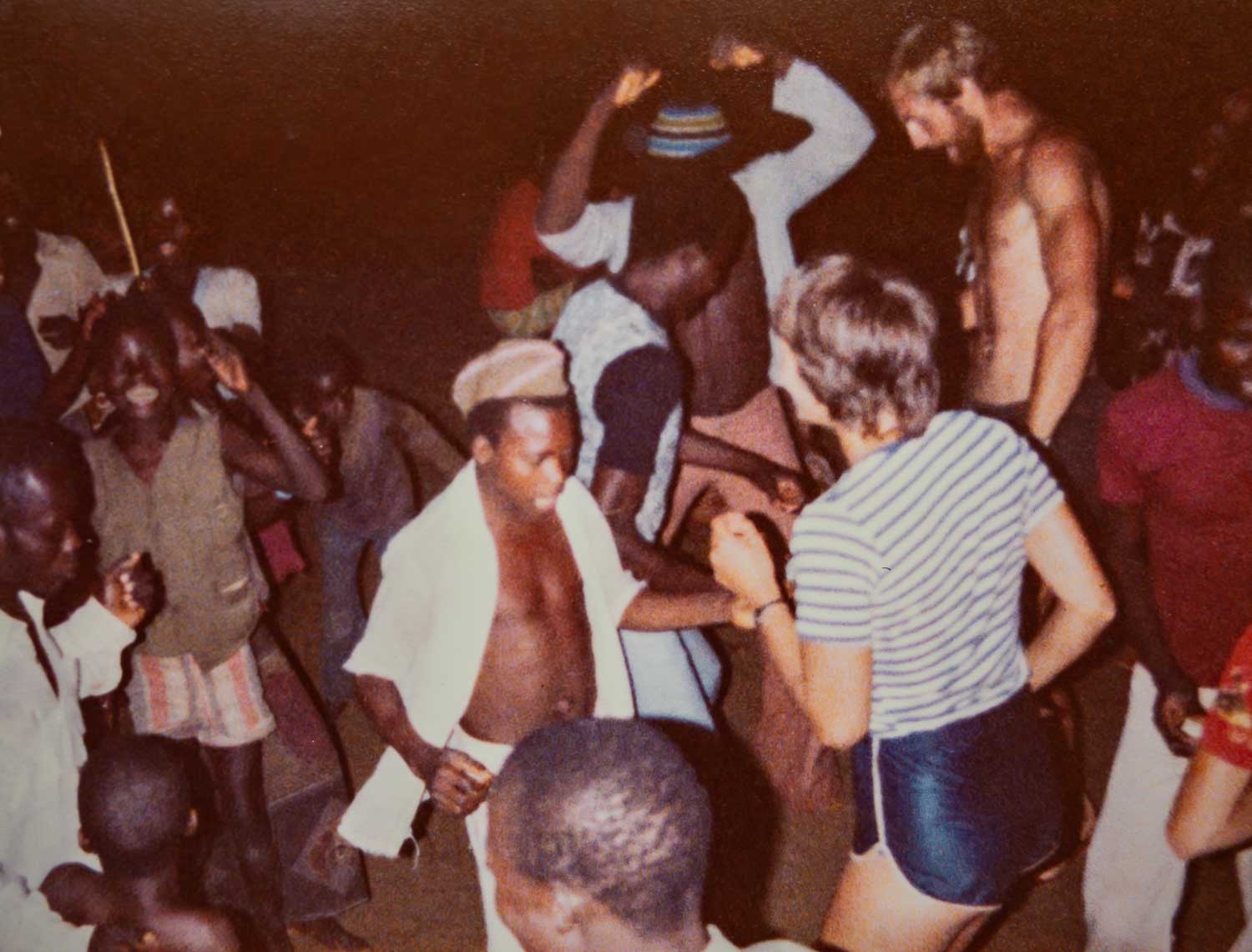
Except me. Dinner is over, but I am determined to make granola for the group. I keep a low fire going and throw the ingredients into the pan, oats and nuts and a little oil, and stir gently until it’s all toasted, while I watch the others dance, taking this rare chance to really cut loose.
And the best thing on this whole 1300 kilometre journey, from the Sudan border to Bangui in the Central African Republic, is Kembé Falls, just eighty kilometres from Bangassou.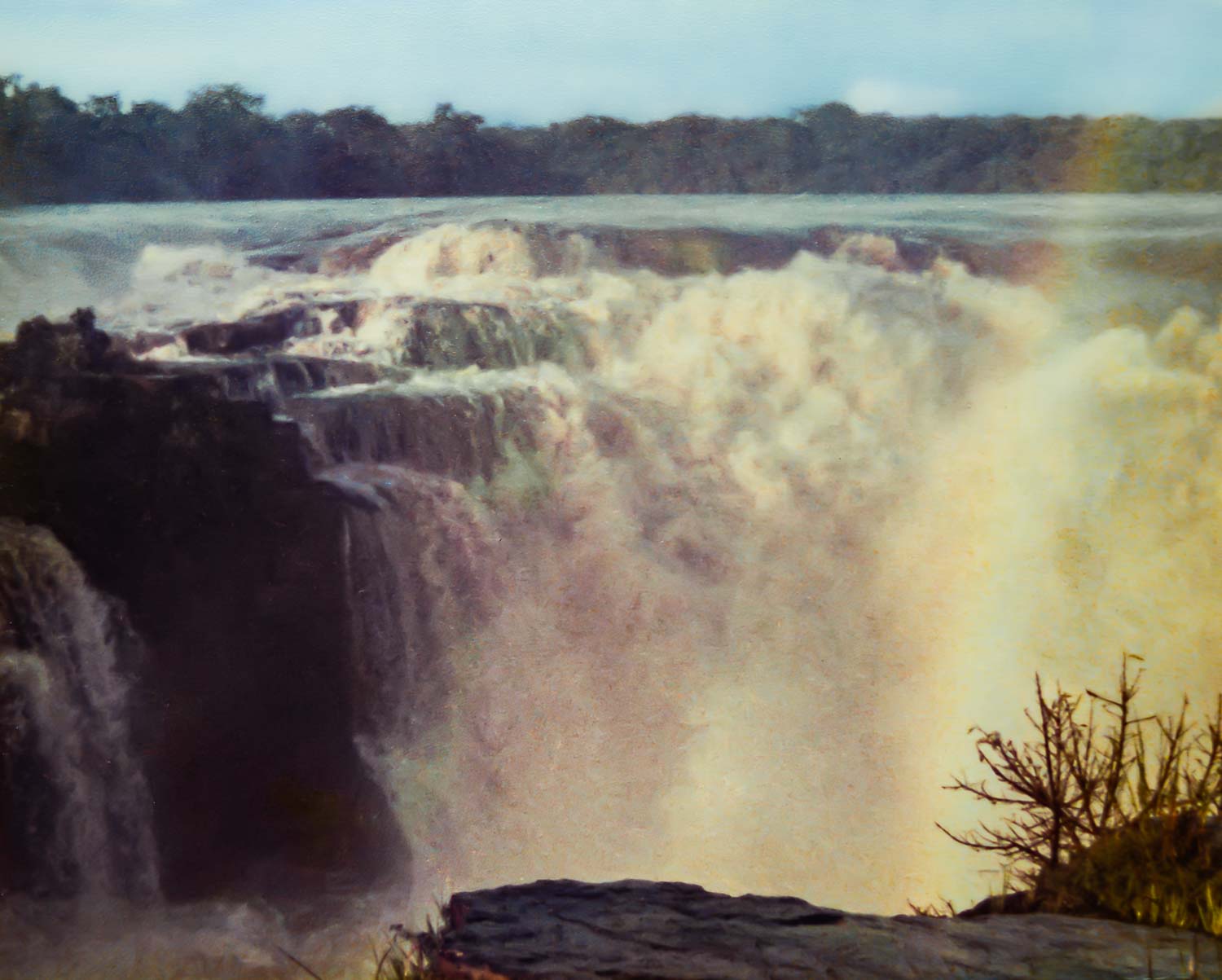
There’s are ledges at the edge of the falls where we can sit and let the warm water wash over us, and a campsite on the expansive flat rocks. We wash body and clothes until everything is squeaky clean. Craig ties a rope to his ankle with Brett holding the other end, in case he slips and gets washed over! It looks so silly, like something from a cartoon, and I doubt they think it’s really a serious safety net.
Meanwhile we women go to a calmer spot and luxuriate in the clean warm water. Everything is washed.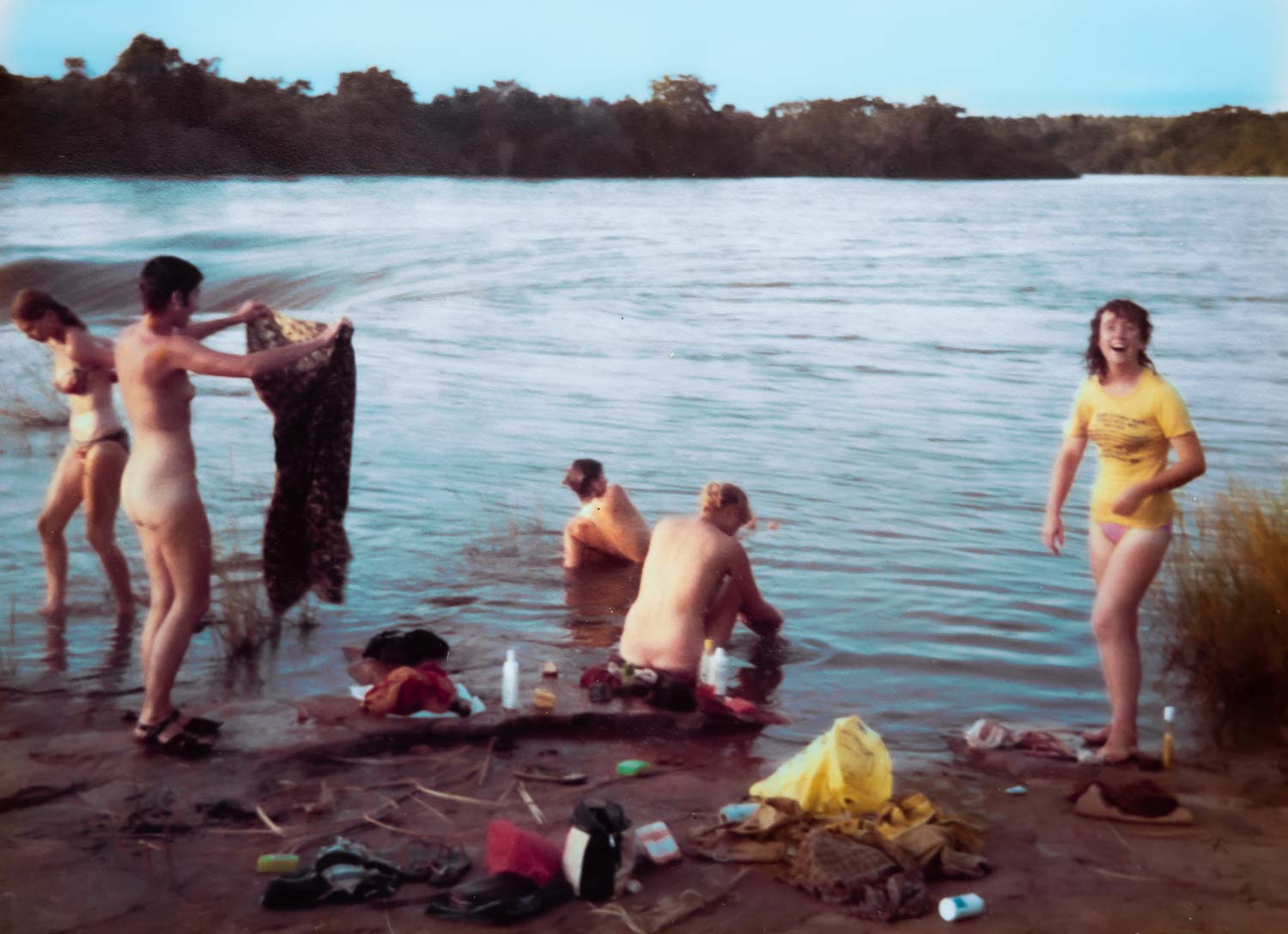
And we all finally relax on the rock ledges in the soft sunset light, clean, content, happy.
We are all adventurers. It is the reason we chose to come on this journey. And while it is at times stressful, and challenging, and we are almost always filthy and often tired, there is also the excitement of it, as if we are pioneers exploring a distant and alien land, putting ourselves into a place where we have to rely on ourselves and the others we are with, and be patient and brave and accepting and cheerful. We can rail against it, or we can surrender to it. In a land that is almost impossible to traverse, and that has seen decades of unrest, I never feel unsafe. Looking back it feels as if our entire expedition was held in a kind of bubble, as if, as long as we did our part, there was nothing that could harm us.
Next post: At last! Bangui! Ten days camped at the edge of one of the most isolated, and poorest cities in the world. An urgent quest for help, and oh yeah, the fight I mentioned in post 4.
Disclosure:
1. I’ve changed the names of everyone involved for privacy
.
2. Obviously any photo with me in it was taken by another member of the group, but I’ve no idea who. We all swapped photos when we got to London.
Previous posts:
1. The Drums Of Africa
2. Tanzania Mania
3. Wildlife And Tribal Life In Kenya
4. The Opposite Of Glamping
5. Turn left At Sudan
6. Mud Luscious and Puddle Wonderful. Central African Republic
All words and images by Alison Louise Armstrong unless otherwise noted
© Alison Louise Armstrong and Adventures in Wonderland – a pilgrimage of the heart, 2010-2024.

Amazing. You are made of stronger stuff than me. I have nothing but admiration for anyone who partakes in this kind of journey. I am so loving these entries.
LikeLiked by 1 person
Thanks so much Darlene. Well I was only 30 at the time, and everyone else was in their 20s/30s except one woman who was 40 – and I thought she was old 😂 OMG the hubris of youth! I don’t think any of us really realized how difficult it was going to be, possibly not even Craig who was leading us. Still, we made it through. I’m glad you’re enjoying. It’s such a rich creative project for me putting these posts together.
Alison
LikeLiked by 1 person
Marvelous stuff, Alison. I’m passing your posts onto other half, Graham. He did the trip in the opposite direction in ’86 I think. So many of your photos could be from his archive too. Africa! What a continent.
LikeLiked by 1 person
Thanks so much Tish. Oh, amazing that Graham did the same trip. Did he do it with an overland company or privately? Either way it’s an enormous adventure. And yes, what a continent!
Alison
LikeLike
He went with a UK based company. I’m very envious he did all this before he knew me. But the trip inspired him to find ways of working in Africa, which in the end led to me being in Kenya. He began by doing 2 years VSO in Tanzania, living in Tabora and working with farmers. And so one thing led to another…
LikeLiked by 1 person
It’s likely he went with Exodus Expeditions, like I did, or Encounter Overland. There was one other company but those were the main two doing Africa overland back then. I went with Encounter in South America.
LikeLike
He went with Hobo Trans Africa Expeditions run by Jo Jordan and husband Nick. They were also building a house in Tanzania. She writes about their pursuits in ‘African Approaches’ an Indepenpress Publication.
LikeLiked by 1 person
A new to me company – will check out their book.
LikeLike
how great
LikeLiked by 1 person
Thanks Beth. It really was amazing.
Alison
LikeLike
I’m truly enjoying your posts about this trip and look forward to every one.
LikeLiked by 1 person
Thank you so much Julia! I’m having so much fun putting these posts together. Probably about 5 more to come.
Alison
LikeLiked by 1 person
What an amazing adventure!
LikeLiked by 1 person
It really was! Looking back I can hardly believe what we did.
Alison
LikeLike
What a thrill it must have been to reach that waterfall where you can wash yourselves and your clothes after all of that mud! The bilharzia sounds frightening though and on top of all of these other things to worry about. Another great chapter to your trip Alison, Maggie
LikeLiked by 1 person
Thanks Maggie. As far as I know none of us got bilharzia. Thank goodness. I know for sure that most of us were checked out by tropical diseases specialists in London, though I didn’t stay in touch with anyone beyond a few months in England the winter of 80-81.
That waterfall was pure heaven!
Alison
LikeLiked by 1 person
How wonderfully delightful to clean everything and relax at the falls! I must say I’m surprised that you forwent the dancing for cooking. 😉
LikeLiked by 1 person
I too am surprised that I went for cooking rather than dancing! What was I thinking?!
Kembé Falls was such a relief. Appreciated all the more for having slogged through the mud to get there.
Alison
LikeLike
I was so relieved when you got to the waterfall, Alison. I’ve never been one for ankle deep mud so I was glad to have a clean ending.
LikeLiked by 1 person
We were so relieved to get to the waterfall too. It was such luxury! (But we were still only half way there so there was a lot more mud to come).
Alison
LikeLike
🙄🩵
LikeLiked by 1 person
The very definition of ‘Odyssey‘… and a thoroughly engaging one.
Thanks for taking us along.
LikeLiked by 1 person
Thanks Keith. Yes, it truly was an epic journey, and for sure the toughest traveling I’ve ever done. Having a grand time putting these posts together; it’s such a rich creative project. I wish I remembered more.
Alison
LikeLike
You probably thought you were the ones going out to see exotic things and people, but it sounds as if, for the folks in the villages, the exotic things and people came to them!
LikeLiked by 1 person
Oh no doubt at all that it went both ways. In those days, pre internet and cell phones, we were a pretty rare breed in those parts for sure.
Alison
LikeLiked by 1 person
Journeys like this are the ones that make us question our decisions to go on them instead of spending our time on things that are less stressful. But they also make the most memorable travel experiences and the greatest stories. The scene of those villagers helping you all with the truck must have been really impressive!
LikeLiked by 1 person
You know I never once questioned my decision. I never have been able to live a conventional life. I think my middle name is adventure. And you’re right, these kinds of journeys make for the best memories, and the best travel stories.
I wish I’d taken photos of the villagers moving our truck! I wish I’d taken photos of so many things that I didn’t think of at the time.
Alison
LikeLiked by 1 person
Oooh, more fun for me! Haha – I just love reading all these posts and am (sort of) glad I am doing this overlanding trip across Africa vicariously! (at least at this age) Our daughter works in public health and has spent quite a lot of time in various African countries. My scariest time as a mother during those years was when everyone in her group was thrown from a raft into the Nile in Uganda and swallowed tons of water … needless to say, we were all on pins and needles until the schistosomiasis tests came back negative!
LikeLiked by 1 person
Thanks Lexie. So glad you’re enjoying! OMG I can’t imagine the scare of swallowing schisto-infected water. Bad enough wading into it. We were all low-key freaked out about it, but AFAIK all of us came away clean.
Alison
LikeLiked by 1 person
Well this is fascinating! I somehow managed to miss the previous posts and will be reading them all, one by one! How very adventurous you were! Even in my adventurous twenties, I was too afraid of exotic diseases to do anything quite like this. But the memories you must’ve made – what a journey! And then… back to normal life. Or not?
LikeLiked by 1 person
Thanks so much TSMS. We were all vaccinated for everything possible, and then got checked out by a tropical diseases specialist in London at the end, but I do understand your reluctance to encounter any of those exotic diseases. They can be nasty! This expedition through Africa was by far the toughest travelling I’ve ever done. It really was epic.
My life has never been normal. Somehow I was always unable to live a conventional life. I went from spending the winter in England to 6 months in the far northwest of Canada cooking in wilderness hunting camps. I later ended up spending several years there. I’ll write about it eventually.
Alison
LikeLiked by 1 person
Alison, like the other commenters, I’m surprised you didn’t join the impromptu dance party in the village and kept on making granola!
Thankfully you all came away from the CAR bilharzia-free. My parents were pretty concerned about tropical diseases when I first moved to Indonesia. We don’t have yellow fever here, but malaria remains endemic in parts of the country, especially in the remoter eastern provinces. Bama has also just told me there is one national park and highland lake in the heart of Sulawesi where bilharzia is known to exist! I actually had a bout of dengue during the pandemic (which I mistook for Covid until the test result came back negative), but luckily Bama knew what to do to get me back in good health. My parents still have no idea I contracted dengue.
Kembé Falls must have felt like a bit of heaven. I can just sense the magic in that shot of everyone basking on the flat rocks in the golden light of sunset. Hopefully after all that mud, Bangui provided some degree of comfort and slightly better roads. I guess we’ll find out in the next instalment!
LikeLiked by 1 person
I too am surprised I didn’t join the dancers! I love to dance! I can only think that the granola gremlins had gotten a hold of me and wouldn’t let go 😂
Oh dengue! That must have been horrible. Good thing Bama knew what to do to help you.
I do think we were all lucky to escape the dreaded bilharzia (AFAIK). Most of us went to see a tropical diseases specialist in London and got a clean bill of health. I can’t remember what we did about malaria in those days. I know I had every vaccination I could get before I left Australia.
Kembé Falls *was* heaven! And deeply relaxing and nourishing.
The roads were slightly better in Bangui, but we were still camping so not much in the way of extra comforts. Except French patisseries! They provided a lot of comfort 😁
Alison
LikeLiked by 1 person
Amazing story telling of an amazing adventure. I really enjoy your writing style. These photos are great as well. Thanks for sharing this stuff.
LikeLiked by 1 person
Thank you so much Skip. I’ve read many of your posts on Travel Refocused and have been kind of in awe of them, so I very much appreciate your comment.
It *was* an amazing adventure, and for sure the hardest travel I’ve ever done, but so worth it. I knew nothing about photography at the time, and had a point-and-shoot camera. It’s been interesting/frustrating/sometimes rewarding to try to bring old faded print photos to life in Lightroom. And also I’m amazed at what I *didn’t* photograph! There was so much more, but I think at this point we were just so focused on moving forward.
Alison
LikeLike